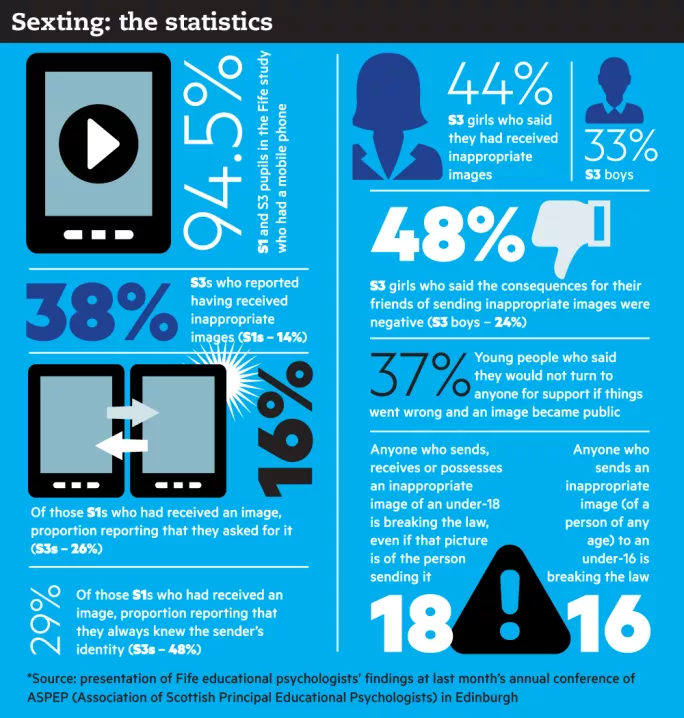Teach 10-year-olds about ‘devastating’ sexting effects

Children should be taught about the dangers of sexting from P7, according to the authors of a major report, who have said that pupils risk “absolutely devastating” consequences when they share explicit pictures.
But pupils rarely go to teachers for help when things go wrong - and those who did, did not find it helpful, the researchers found.
And some schools, it warns, are reluctant to deal with sexting at all because they see it as parents’ responsibility. But the researchers also say schools should acknowledge that sexting is widely viewed by teenagers as normal behaviour, and that teachers will lose credibility if they overstate the negatives.
The research by Fife Council educational psychologists - to be published in the coming weeks - is thought to be the most extensive examination of sexting by any Scottish local authority, with over 800 S1 and S3s completing online surveys just before the summer.
‘There can be a really significant impact on pupils’ emotional wellbeing’
While 38 per cent of S3s had received inappropriate images - defined as naked or nearly naked pictures - a large minority of S1s had, too (14 per cent).
“There can be a really significant impact on pupils’ emotional wellbeing,” said Fife acting principal educational psychologist Vivienne Sutherland, who added that, in a small number of cases, the impact could be “absolutely devastating”. The effects could include suicidal thoughts, self-harm, low attendance and disengagement from learning, she said.
But “a lot of school staff feel very nervous” about sexting and there were differing views over who should take responsibility. “Some schools said it was a very serious issue… others were going, ‘It’s really nothing to do with us, it happens outwith school, so really parents should be dealing with it’, without realising the impact it was having on their pupils,” said Ms Sutherland.
Schools should inform pupils that behaviour they might consider normal could be illegal (few students know this - see graphic, below) and have “catastrophic” repercussions, and that “once [an image] is online you can’t take it down”, she added.
A large majority of S1s receiving images had not asked for them (the same was true for S3s) and they were more likely than S3s to receive images from a stranger. But the Fife team found some reluctance among school staff and parents to accept that S1s might be involved in sexting. Ms Sutherland said that even “P7 kids won’t be completely oblivious” about sexting and that this was a good stage to start tackling the issue in schools.

Tailored approaches
Eileen Prior, executive director of the Scottish Parent Teacher Council, said the appropriate age to start such work was whenever children were expressing concerns about sexting, and that schools must not leave it to parents. “You can’t simply say, ‘That happens outside the school gates, so we can’t deal with it,’” added Ms Prior, who drew a parallel with schools’ reluctance to tackle bullying in the past.
The Fife team said that approaches should be tailored for different ages. Work with older pupils, for example, should acknowledge that they may consider sexting unremarkable, and that hammering home worst-case scenarios - similar to “just say no” drugs messages - may undermine teachers’ credibility if they do not also offer pragmatic advice for those who are sexting.
‘The pressure came from my female friends mostly, because we thought boys would find it sexy’
Fife’s educational psychologists also advise different approaches for boys and girls, since the dynamics of sexting split along gender lines: girls, for example, were more likely to send an image - and to suffer negative consequences - while boys were more likely to ask for one.
Kara Brown, co-director of YWCA Scotland - The Young Women’s Movement, pointed to research by her organisation that showed that many girls struggled to deal with social media and that it contributed to “confusion, pressure and discomfort around sexual identities” (see the report here).
One girl who posted sexual pictures said: “The pressure came from my female friends mostly, because we thought boys would find it sexy. It was almost a competition.”
Ms Brown’s organisation has started a network for pupils to discuss sexting in a safe environment, which also invites teachers to take part.
You need a Tes subscription to read this article
Subscribe now to read this article and get other subscriber-only content:
- Unlimited access to all Tes magazine content
- Exclusive subscriber-only stories
- Award-winning email newsletters
Already a subscriber? Log in
You need a subscription to read this article
Subscribe now to read this article and get other subscriber-only content, including:
- Unlimited access to all Tes magazine content
- Exclusive subscriber-only stories
- Award-winning email newsletters